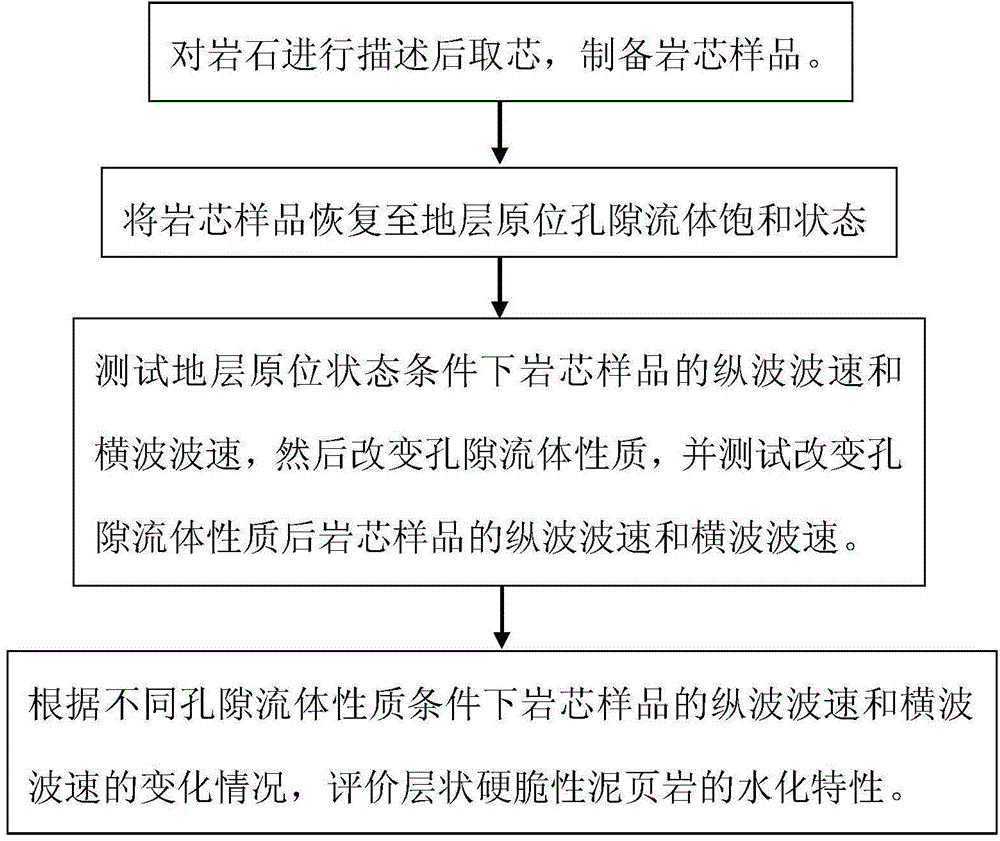Evaluation method for hydration characteristics of layered hard brittle mud shale
A technology of mud shale hydration and evaluation method, which is applied in earth-moving drilling, analysis of solids using sonic/ultrasonic/infrasonic waves, wellbore/well components, etc. Micro-fractures swell in contact with water, etc., to achieve the effect of simple and easy-to-understand evaluation methods, prevention of wellbore instability, and high repeatability
- Summary
- Abstract
- Description
- Claims
- Application Information
AI Technical Summary
Problems solved by technology
Method used
Image
Examples
Embodiment 1
[0057] Such as figure 1 As shown, a method for evaluating the hydration characteristics of layered hard and brittle shale includes the following steps in order:
[0058] Step 1: Describe the rock and take the core to prepare a core sample;
[0059] Step 2: Restore the core sample to the in-situ pore fluid saturation state of the formation;
[0060] Step 3: Test the longitudinal wave velocity and shear wave velocity of the core sample under the in-situ condition of the formation, then change the properties of the pore fluid, and test the longitudinal wave velocity and shear wave velocity of the core sample after changing the properties of the pore fluid;
[0061] Step 4: Evaluate the hydration characteristics of the layered hard and brittle shale according to the changes in the longitudinal wave velocity and the shear wave velocity of the core samples under different pore fluid properties.
[0062] In step 1, the rock has a set of joints, and the inclination angle between the joint surfa...
Embodiment 2
[0081] A method for evaluating the hydration characteristics of layered hard and brittle shale. The steps, principles, evaluation devices adopted, and beneficial effects are the same as those in the first embodiment. The difference is:
[0082] In step 1, drill three core samples. The shape of the core sample is cylindrical and the length is 3 times the diameter. After grinding, the diameter is 25mm and the length is 75mm. The diameter of the core sample is 20 times the diameter of the largest particle in the rock. Measure two mutually perpendicular diameters at the bottom, middle, and upper part of each core sample, and take the average of the measurement results, which is the final diameter of the core sample.
[0083] In step 2, the method to restore the core sample to the in-situ pore fluid saturation state of the formation is to prepare a potassium chloride solution with the same properties as the pore fluid in the in-situ formation state, and immerse the core sample in the ...
PUM
 Login to View More
Login to View More Abstract
Description
Claims
Application Information
 Login to View More
Login to View More - R&D
- Intellectual Property
- Life Sciences
- Materials
- Tech Scout
- Unparalleled Data Quality
- Higher Quality Content
- 60% Fewer Hallucinations
Browse by: Latest US Patents, China's latest patents, Technical Efficacy Thesaurus, Application Domain, Technology Topic, Popular Technical Reports.
© 2025 PatSnap. All rights reserved.Legal|Privacy policy|Modern Slavery Act Transparency Statement|Sitemap|About US| Contact US: help@patsnap.com



